Communist mummies
The bodies of several Communist heads of state have been mummified and displayed for the public. The practice began following the death of Soviet leader Vladimir Lenin. Since 1924, his remains have been exhibited at Lenin's Mausoleum in the Red Square. Since Lenin, a series of Communist and state-socialist heads of state have been similarly preserved and displayed, often encased in glass and available for public viewing in mausoleums. Current leaders on display include Lenin, Ho Chi Minh, Mao Zedong, Kim Il Sung, and Kim Jong Il.
Background
Early corpse preservation by humans is known from the Chinchorro mummies and Ancient Egyptian funerary practices.[1]
Preservation technologies improved rapidly during the 18th and 19th centuries, with Dutch anatomist Frederik Ruysch innovating a chemical embalming solution (liquor balsamicum) containing mercury oxide, Prussian blue, and clotted pig's blood. His anatomical museum was visited by Peter the Great, who said "I saw boys and girls 4 years old, visibly well vascularized, with open eyes and soft little bodies, and they were not even in alcohol." Ruysch sold his "repository of curiosities", including his embalming recipe, to Peter the Great for 30,000 guilders in 1717.[2] Anatomists continued to make advances in embalming chemicals, significantly in 1859 with the identification of formaldehyde by Russian chemist Aleksandr Butlerov.[3] Following the death of Russian physician Nikolay Pirogov in 1881, he was embalmed using methods he devised. His remains are relatively well-preserved, entombed in a glass-lidded coffin at a church in Vinnytsia.[4]
History
Preservation of Lenin
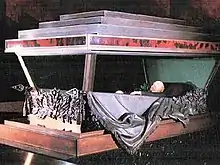
Following the death of Soviet leader Vladimir Lenin on 21 January 1924, he was embalmed by Aleksey Abrikosov. On 24 January 1924, his body was displayed in the Kremlin's Hall of Columns. His internal organs were removed during the autopsy,[5] and his brain was dissected. Lenin's body was transferred to the Red Square and placed in a temporary wooden mausoleum. For two months cold weather kept Lenin's remains relatively undeteriorated as hundreds of thousands of Russians came to pay their respects. A committee chaired by Felix Dzerzhinsky was formed to deliberate on the preservation of Lenin's body[6] and Leonid Krasin made an unsuccessful attempt to preserve the body cryogenically. In March, biochemist Boris Zbarsky and anatomist Vladimir Vorobiev tried an experimental embalming technique.[7] The decision to display Lenin on a permanent basis was not made until 26 July. It was not until 1929 or 1930 that Lenin was put in the stone mausoleum.
Preservation and repair of Lenin's body has been ongoing since 1924. A Soviet team of specialists informally known as the "Lenin Lab" (now known as the Russian Biomedical Technology Research and Training Centre) was responsible for the body. The annual cost of preserving Lenin's corpse was $200,000 in 2016.[8] The specialists for Lenin's body also preserved the corpses of Ho Chi Minh, Kim Il Sung, and Kim Jong Il.[9]
Spread to other countries
Since the embalming of Lenin, the Soviet practice spread to other Communist countries in the Eastern Bloc and elsewhere. Following the death of Communist Bulgaria leader Georgi Dimitrov in 1949, his corpse was embalmed and put on display at the Georgi Dimitrov Mausoleum. It remained there until 1990.[10] Like his predecessor, Soviet leader Joseph Stalin was embalmed and put on display next to Lenin in Lenin's Mausoleum. The Soviet leaders lay side-by-side for around eight years before Stalin was removed in a de-Stalinization purge.[11] Czech leader Klement Gottwald was embalmed and preserved in a mausoleum at the National Monument at Vítkov from 1953 to 1962, before finally being cremated.[12]
While not a head of state, Argentine First Lady Eva Perón was embalmed in 1952[13] and her blood was replaced with glycerine in order to preserve the organs and lend an appearance of "artistically rendered sleep". Her body was to be displayed publicly in a monument that was being constructed. Meanwhile, her body was displayed in her former office at the General Confederation of Labour building for almost two years. Before the monument was completed, Juan Perón was overthrown in a 1955 coup, and the military dictatorship secretly transported her body to Italy, where it remained until 1971.[14]
Following the death of Ho Chi Minh in 1969, Soviet scientists from the Lenin Lab were flown into Vietnam to assist in the preservation of the body. Chemicals and equipment were also flown in. The initial embalming process took place at a temporary tomb in a secret underground chamber north of Hanoi.[15] After the collapse of the Soviet Union, Russia started charging Vietnam for the embalming chemicals.[16]
While Chinese leader Mao Zedong wanted to be cremated, he was embalmed following his death in 1976. His remains were preserved with formaldehyde, during which his head was said to have "swelled up like a football".[17]
In 1979 after the death of Angolan President Agostinho Neto in Moscow, the same Russian technicians who had worked on Lenin's corpse embalmed Neto. Neto was ultimately buried in 1991 in accordance with the wishes of his former spouse.[18]
While not a Communist, the body of President of the Philippines Ferdinand Marcos was preserved following his death in 1989.[19]
Following the death of North Korean leader Kim Il Sung in 1994, he was embalmed by Russian scientists. He is displayed in a mausoleum in the Kumsusan Palace of the Sun in Pyongyang. After Kim Jong Il died in 2011, he joined his father on display after being embalmed by scientists from the Lenin Lab in a laboratory that was built into the mausoleum.[16]
Following the death of Venezuelan leader Hugo Chávez in 2013, plans to embalm and permanently display his body in a transparent sarcophagus[20] were abandoned after German and Russian scientists concluded that too much time had passed to properly preserve it.[21]
With the exception of Fidel Castro, the founder of every Communist state has been preserved.[22] Virtually none of the leaders wanted to be mummified.
Preservation
Lenin's remains are preserved by the "Lenin Lab", officially the Center for Scientific Research and Teaching Methods in Biochemical Technologies, which has a "Mausoleum group" consisting of five or six anatomists, surgeons, and biochemists.[7] The centre has treated its embalming techniques as a state secret. By 1993, the centre had 150 employees.[6] The centre has assisted in the preservation of Ho Chi Minh, Kim Il-sung and Kim Jong-il, among others.[7] Ilya Zbarsky and his father Boris Zbarsky both headed the embalming processes as Lenin's Mausoleum.[23] The Lenin Lab concentrates on preserving the physical form and not the biological tissue. Flesh and skin are sometimes replaced with plastic and other materials. In the case of Lenin's remains, his blood vessels and arteries were removed during autopsy, so he wears a double-layered rubber suit and scientists use microinjection techniques to deliver embalming fluids. According to anthropologist Alexei Yurchak, the bodies are re-embalmed every one and a half to two years.[24] During the six-week process, the body is submerged in formaldehyde, alcohol, hydrogen peroxide, potassium acetate, sodium acetate, acetic acid and glycerol solution baths. Lenin's skin fat has largely been replaced with a flexible material composed of carotene, glycerin, and paraffin.[7]
Mausoleums where leaders' bodies are preserved for public exhibition serve as pilgrimage sites and tourist attractions.[25]
Table of preserved heads of state
| Leader | Location | State | Dates of preservation | Notes |
|---|---|---|---|---|
| Soviet Union | 1924 | During World War II, when Nazi armies threatened to enter Moscow, Lenin's body was removed to Tyumen, Siberia.[26] In 2019, over 2.5 million people queued to see Lenin's remains.[27] A new set of clothing is ordered for Lenin every three years.[23] | ||
| People's Republic of Bulgaria | 1949–1990 | Following Dimitrov's death in Russia, the Georgi Dimitrov Mausoleum was built in six days.[28] Dimitrov's body was embalmed and encased in glass. In 1990, his remains were cremated and the ashes were buried in Central Sofia Cemetery.[29] | ||
| Mongolian People's Republic | 1952 | Choibalsan was embalmed by Soviet scientists from the Lenin Lab,[30] but was not "accorded long-term preservation" under the direction of the Kremlin.[31] His body was initially buried in the Altan Ulgii cemetery in Ulaanbaatar before being transferred to Sükhbaatar's Mausoleum in 1954. His remains were cremated after the mausoleum was torn down in 2005. | ||
| Soviet Union | 1953–1961 | Following his death in 1953, Stalin was embalmed and placed in Lenin's Mausoleum next to Lenin.[32] Stalin was removed from Lenin's Mausoleum in 1961 during the period of De-Stalinisation and interred in the Kremlin Wall Necropolis. | ||
| Czechoslovak Socialist Republic | 1953–1962 | Gottwald died in office in 1953 after attending the funeral of Stalin. His body was embalmed and displayed in a mausoleum at the National Monument at Vítkov. In 1962, his body was cremated, the ashes returned to the Žižka Monument and placed in a sarcophagus. Some accounts relate that his body had blackened and was decomposing due to a botched embalming, although other witnesses have disputed this.[33] | ||
| Vietnam | 1969 | A team of Russian and Vietnamese scientists was convened to assess the state of Ho's remains in 2019.[34] | ||
| China | 1976 | |||
.jpg.webp) Mausoleum of Agostinho Neto | Angola | 1979–1991 | After dying in Moscow, Neto was embalmed by Soviet scientists. His mausoleum in Luanda was nicknamed "Angola's Sputnik".[35] | |
| Guyana | 1985 | Burnham was buried briefly before being exhumed and transported to the Soviet Union for preservation by the Lenin Lab. His body was returned in 1986 but was never publicly exhibited.[30] | ||
| Philippines | 1993–2016 | Marcos was kept in a refrigerated glass-encased coffin and put on public display shortly after his remains were brought to Ilocos Norte from the United States in 1993. His body was re-interred at the Libingan ng mga Bayani cemetery in Taguig on November 18, 2016. | ||
| North Korea | 1994 | Embalmers from the Lenin Lab spent nearly a year preparing Kim Il Sung's body for display. In the book North of the DMZ, Andrei Lankov writes that North Korea was rumoured to have paid $1 million for the embalming.[36] | ||
| North Korea | 2011 |
See also
References
- Doyle, Siobhan (8 October 2018). "Keeping it under wraps: mummy revelations exposé". The Institution of Engineering and Technology. Archived from the original on 1 September 2020. Retrieved 7 September 2023.
- Brenner, Erich (March 2014). "Human body preservation - old and new techniques". Journal of Anatomy. 224 (3): 316–344. doi:10.1111/joa.12160. PMC 3931544. PMID 24438435.
- Butlerow, A (1859). "Ueber einige Derivate des Jodmethylens" [On some derivatives of methylene iodide]. Annalen der Chemie und Pharmacie (in German). 111: 242–252. Archived from the original on 2023-01-12. Retrieved 2023-09-07.
- Yegorov, Oleg (13 August 2018). "3 famous Russian mummies who are not Lenin". Russia Beyond.
- Yurchak, Alexei (1 February 2015). "Bodies of Lenin" (PDF). Representations. 129 (1): 116–157. doi:10.1525/rep.2015.129.1.116.
- Higgins, Andrew (1 June 1993). "End is nigh for mummified Marxists: Andrew Higgins meets Moscow's". The Independent. Archived from the original on 30 May 2023. Retrieved 7 September 2023.
- Hsu, Jeremy (22 April 2015). "Lenin's Body Improves with Age". Scientific American. Archived from the original on 25 May 2023. Retrieved 7 September 2023.
- "Russia reveals cost of preserving Lenin's body". BBC News. 13 April 2016. Archived from the original on 10 May 2023. Retrieved 7 September 2023.
- "Body language: The Russian science keeping North Korea's dead leaders looking fresh". Reuters. 5 March 2019. Archived from the original on 8 September 2023. Retrieved 7 September 2023.
- Kelleher, Michael (1 August 2009). "Bulgaria's Communist-Era Landscape". The Public Historian. 31 (3): 39–72. doi:10.1525/tph.2009.31.3.39.
- Dewey, Caitlin (8 March 2013). "A photographic guide to the world's embalmed leaders". Washington Post. Archived from the original on 20 June 2023. Retrieved 7 September 2023.
- Vacín, Luděk (28 June 2013). "The Power of the Preserved Body: Embalming and Display of Communist Leaders with a Focus on Georgi Dimitrov and Klement Gottwald". Tagung zur Königsideologie: Royal versus Divine Authority. Acquisition, Legitimization and Renewal of Power. Archived from the original on 8 February 2023. Retrieved 7 September 2023.
- "Body politics: famous preserved corpses". Yahoo News. 11 September 2016. Archived from the original on 9 October 2016. Retrieved 7 September 2023.
- Fraser, Nicholas; Navarro, Marysa (1996). Evita: The Real Life of Eva Perón. W.W. Norton & Company. p. 164.
- Kalmusky, Katie (10 May 2018). "How Ho Chi Minh's Body is Kept Preserved". Culture Trip. Archived from the original on 4 December 2022. Retrieved 7 September 2023.
- Smith, Josh (5 March 2019). "Body language: The Russian science keeping North Korea's dead leaders looking fresh". Reuters. Archived from the original on 8 September 2023. Retrieved 7 September 2023.
- "Preserving Chairman Mao: embalming a body to maintain a legacy". The Guardian. 11 September 2016. Archived from the original on 24 April 2023. Retrieved 7 September 2023.
- Corfield, Justin (20 April 2009). "Neto, Agostinho (1922-1979)". The International Encyclopedia of Revolution and Protest: 1–2. doi:10.1002/9781405198073.wbierp1086. ISBN 9781405184649.
- Westcott, Kathryn (8 March 2013). "Why are some leaders' corpses preserved?". BBC News. Archived from the original on 18 January 2022. Retrieved 7 September 2023.
- Carroll, Rory; Lopez, Virginia (7 March 2013). "Hugo Chávez's body to be embalmed and displayed 'eternally'". The Guardian. Archived from the original on 18 July 2023. Retrieved 7 September 2023.
- "Venezuela's Hugo Chavez unlikely to be preserved 'for eternity'". NBC News. 13 March 2013. Archived from the original on 8 September 2023. Retrieved 7 September 2023.
- Stilwell, Blake (14 September 2022). "5 Dead But Embalmed Communist Leaders You Can Go See Right Now". Military.com. Archived from the original on 15 September 2022. Retrieved 7 September 2023.
- "Who, What, Why: How do you embalm a leader?". BBC News. 21 December 2011. Archived from the original on 4 April 2023. Retrieved 7 September 2023.
- "Russian know-how keeps dead Kims looking fresh - Taipei Times". Taipei Times. 7 March 2019. Archived from the original on 7 July 2022. Retrieved 7 September 2023.
- Williams, Sue (10 July 2019). "Ten dead bodies that are tourist attractions: Famous embalmed bodies on display". The Sydney Morning Herald. Archived from the original on 8 September 2023. Retrieved 7 September 2023.
- Fann, William Edwin (1 December 1999). "Lenin's Embalmers". American Journal of Psychiatry. 156 (12): 2006–2007. doi:10.1176/ajp.156.12.2006. Archived from the original on 8 September 2023. Retrieved 7 September 2023.
- Market, Howard (21 January 2020). "How the quest to preserve Lenin's body helps the living". PBS NewsHour. Archived from the original on 6 September 2023. Retrieved 7 September 2023.
- Borissov, Liubomir (6 August 2020). "Why dynamite couldn't destroy the legacy of Bulgaria's communist mausoleum". New East Digital Archive.
- Sudetic, Chuck (20 July 1990). "Evolution in Europe; Embalmed Body of Bulgarian Communist Is Taken From Mausoleum and Cremated". The New York Times. Archived from the original on 27 November 2022. Retrieved 7 September 2023.
- Yurchak, Alexei (2015). "Form versus Matter: Miraculous Relics and Lenin's Scientific Body". Death and Mortality – from Individual to Communal Perspectives: 61–81. Archived from the original on 2023-09-08. Retrieved 2023-09-07.
- Stanoeva, Elitza (2011). "The dead body of the leader as an organizing principle of socialist public space: The mausoleum of Georgi Dimitrov in Sofia" (PDF). IWM Junior Visiting Fellows' Conference Proceedings. 29: 6. Archived (PDF) from the original on 2023-06-10. Retrieved 2023-09-07.
- Rogachefsky, Marty (2014). "Lenin's Life after Death: An Analysis of the Politics Surrounding the Lenin Mausoleum as a Symbol of Power throughout History". Proceedings of GREAT Day. 2013 (1): 4. Archived from the original on 2023-09-08. Retrieved 2023-09-07.
- "Radio Prague: Exhibition at Vitkov Memorial highlights the Klement Gottwald personality cult". Radio Prague International. 3 August 2012. Archived from the original on 28 March 2019. Retrieved 7 September 2023.
- Pearson, James (19 July 2019). "Vietnam says preserved corpse of Ho Chi Minh in great condition". Reuters. Archived from the original on 8 September 2023. Retrieved 7 September 2023.
- "Father of Angola rots in a grey mausoleum". The Mail & Guardian. 10 October 1997. Archived from the original on 2022-08-18. Retrieved 2023-09-07.
- McCurry, Justin (20 December 2011). "Not-so-eternal leader: Kim Jong-il looks set to miss out on embalming". The Guardian. Archived from the original on 28 March 2023. Retrieved 7 September 2023.
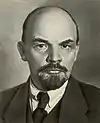
.jpeg.webp)



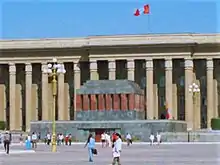
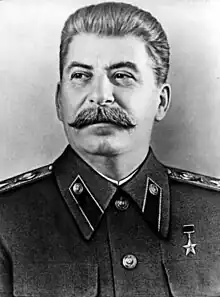
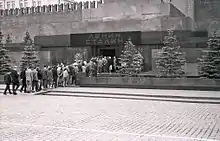
.jpg.webp)
.jpg.webp)

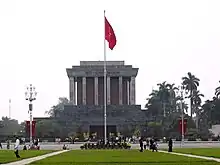
.jpg.webp)

_(cropped).jpg.webp)
.jpg.webp)
.jpg.webp)
.jpg.webp)



